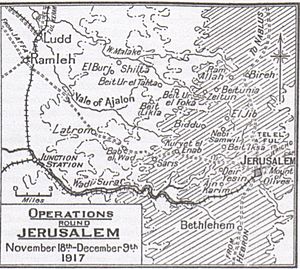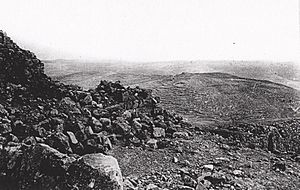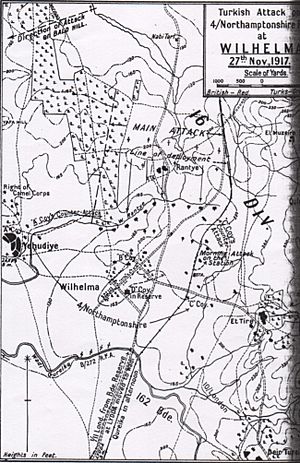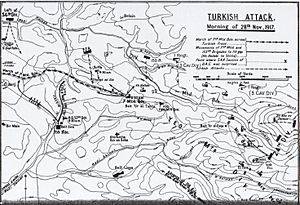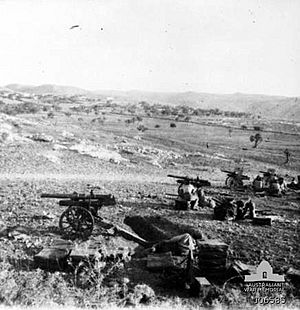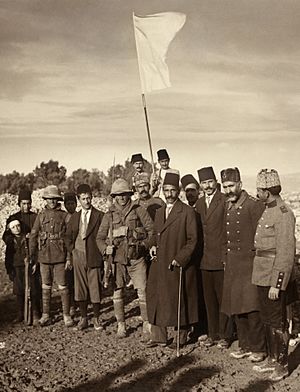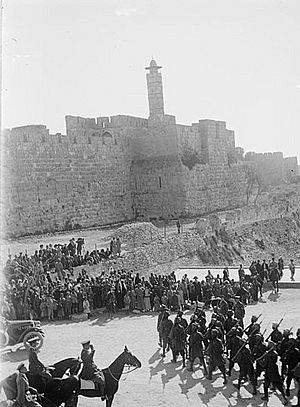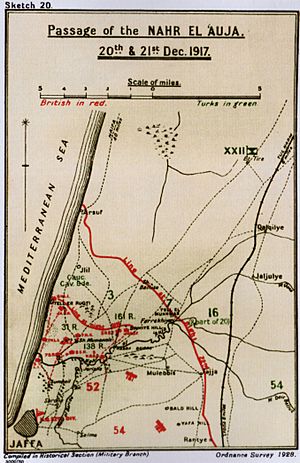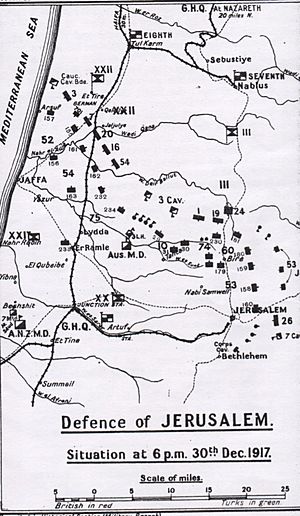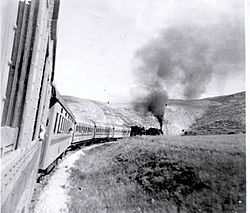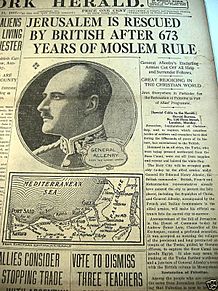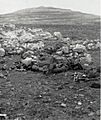Battle of Jerusalem facts for kids
Quick facts for kids Battle of Jerusalem |
|||||||
|---|---|---|---|---|---|---|---|
| Part of the Middle Eastern theatre of World War I | |||||||
 General Allenby enters Jerusalem on foot, 11 December 1917 |
|||||||
|
|||||||
| Belligerents | |||||||
|
|||||||
| Commanders and leaders | |||||||
| Units involved | |||||||
|
Egyptian Expeditionary Force
|
Seventh Army Eighth Army |
||||||
| Casualties and losses | |||||||
| 18,000 (entire campaign) | 25,000 (entire campaign) | ||||||
The Battle of Jerusalem was a series of important fights during World War I. It happened in 1917, when the British Empire tried to capture the city of Jerusalem from the Ottoman Empire. The fighting started on November 17 and continued until December 30, 1917. This battle was a key part of the larger Sinai and Palestine Campaign.
Before Jerusalem was fully taken, there were two main battles in the Judean Hills. These were the Battle of Nebi Samwill (November 17-24) and the Defence of Jerusalem (December 26-30). Another important fight, the Battle of Jaffa, happened on December 21-22.
British Empire forces, including the XX Corps, XXI Corps, and the Desert Mounted Corps, fought against the Ottoman Empire's Seventh and Eighth Armies. The British won these battles, capturing Jaffa and Jerusalem. This was a big loss for the Ottoman Army.
Because of these victories, British forces took control of Jerusalem. They set up a strong new defense line. On December 11, General Edmund Allenby walked into the Old City through the Jaffa Gate. He chose to walk to show respect for Jerusalem, which is a holy city for many religions. The British Prime Minister, David Lloyd George, called the capture "a Christmas present for the British people." This victory greatly boosted morale for the British Empire.
Contents
Why the Battle Happened
British General Edmund Allenby, who led the Egyptian Expeditionary Force (EEF), had recently won a big battle at Battle of Mughar Ridge on November 13. This forced the Ottoman commander, Erich von Falkenhayn, to move his army headquarters. The Ottoman Seventh and Eighth Armies had to retreat.
The Ottoman forces tried to build defenses around Jerusalem. They needed time to reorganize their tired and disorganized army. Meanwhile, the British War Cabinet told Allenby to be careful. They worried about keeping enough British troops in the area. This was partly because Russia was leaving the war, which meant Germany could send more soldiers to other fronts.
Allenby knew the maps of the Judean Hills were not very good. He also knew that attacking strong defenses without enough support could be risky. His troops were tired from fighting and moving far from their supply bases. They were about 35 miles from their main railway supply point.
Allenby decided to attack the Ottoman Seventh Army quickly. He hoped to capture Jerusalem before the Ottomans could fully reorganize or build strong trenches. He wanted to keep pressure on them.
Getting Ready for Battle
Supplying the British Army
Moving supplies like food, water, and ammunition to the front lines was very important. The Ottoman army had destroyed roads and other structures as they retreated. This made it hard for British trucks and camels to bring supplies forward.
The main road from Gaza to Junction Station was narrow and often sandy. Supplies also came by sea to Wadi Sukereir and later to Jaffa. However, Jaffa didn't have good port facilities. Supplies had to be moved from ships to smaller boats and then unloaded on beaches. This depended a lot on good weather.
Feeding the army's horses was a huge job. With 25,000 horses, over 100 tons of grain were needed every day. This meant many trucks were needed just for the horses, plus more for the soldiers' food.
All available trucks and camels were organized into convoys. They moved supplies from the railway to advanced supply points. From there, horse and mule wagons took supplies to the front-line units. Egyptian Labour Corps workers helped load and unload supplies. This was a massive effort to keep the army supplied.
British Advance Continues
On November 15, British General Harry Chauvel ordered his mounted divisions to keep advancing. They moved towards Ramleh and Lud. The Yeomanry Mounted Division reached the Jerusalem road after a daring cavalry charge.
On November 16, the New Zealand Mounted Rifles Brigade captured Jaffa. This forced the Ottoman Eighth Army to retreat north of the Nahr el Auja. This opened up the Ottoman Seventh Army's right side to attack. As a result, the Seventh Army had to move further into the Judean Hills, where they set up defenses.
The Battle Begins
Moving into the Judean Hills
The area around Jerusalem was good for defense, with many hills. The Ottoman Seventh Army had set up trenches and strong points up to 4 miles from Jerusalem. On November 18, Allenby decided to follow the Ottoman army closely into the Judean Hills. He hoped to prevent them from building even stronger defenses.
Allenby wanted to cut off all roads to Jerusalem and force the Ottoman army to leave the city. He ordered two infantry divisions and two mounted divisions to advance. They moved east from Latron, following the Jaffa to Jerusalem road.
The 75th Division moved up the main road. The 52nd (Lowland) Division moved on smaller roads north of the 75th Division. Further north, the Yeomanry Mounted Division aimed to cut the Ottoman supply lines at Bireh, about 8 miles north of Jerusalem. The 53rd (Welsh) Division advanced along the Beersheba to Jerusalem road to take Hebron and Bethlehem.
The British forces began entering the Judean Hills on November 18. The first goal was to capture the high ground around Amwas, so the 75th Division could advance.
75th Division's Difficult Advance
The main road to Jerusalem went through a narrow pass called Bab el-Wad. On November 19, the 75th Division moved up this road. They found Amwas deserted but fought their way to the heights of Bab el Wad.
Beyond Bab el Wad, the road was winding and difficult, going through deep valleys and over rocky hills. Other paths were just rough tracks, making it very hard to move soldiers and artillery. It was almost impossible for artillery to support attacks off the main road.
Winter weather made things even harder. It was cold, wet, and muddy. Heavy rain and early darkness limited visibility. Soldiers had only light summer uniforms and one blanket, offering little protection from the cold rain.
The Ottoman forces here were rearguards, small groups dug in on hills. Indian and Gurkha troops outmaneuvered them to capture these positions.
Ottoman Army Positions
By the evening of November 19, the Ottoman Seventh Army was defending Jerusalem from its headquarters in Nablus. Its forces were spread out to cover the roads leading to Jerusalem. The Ottoman Eighth Army was further north, defending the Nahr el Auja line near the coast.
Trying to Cut the Nablus Road
The 52nd (Lowland) Division tried to advance towards Kuryet el Enab but was stopped by strong Ottoman rearguards with machine guns. On November 21, a mist helped the 75th Division quickly attack and defeat the Ottoman forces with bayonets. That night, troops suffered from the cold and rain.
The Yeomanry Mounted Division struggled to advance towards Bireh, moving across very rough terrain. They faced 3,000 Ottoman troops with artillery. The Yeomanry briefly took a ridge but were forced back by Ottoman reinforcements and heavy rain. They had to retreat after dark.
November 21-24: Battle of Nebi Samwil
The Battle of Nebi Samuel was a key part of the Jerusalem operations. On November 21, the 75th Division's advance was blocked by Ottoman forces on Nebi Samuel hill, which overlooked Jerusalem. British troops captured this hill after fierce fighting. Ottoman counterattacks failed, even reaching the mosque gates before Gurkha infantry pushed them back.
The British suffered over 2,000 casualties in these attacks. The Ottoman Seventh Army managed to stop the British advance for a time. On November 24, Allenby paused the attack to bring in fresh troops.
November 24: First Attack Across the Nahr el Auja
On the same day the advance in the Judean Hills paused, British forces attacked across the Nahr el Auja near Jaffa. The New Zealand Mounted Rifles Brigade established two bridgeheads (secure positions across the river). The goals were to gain land and prevent the Ottoman Eighth Army from sending troops to help the Seventh Army.
New Zealand troops crossed the river and captured key points like Sheikh Muannis. Two infantry battalions then held these positions. However, on November 25, the Ottoman 3rd and 7th Divisions launched a strong counterattack. They pushed the British back across the river.
The fighting was intense. British infantry had to retreat under heavy fire. The New Zealand Mounted Rifles Brigade suffered 11 killed, 45 wounded, and three missing. After this, the New Zealand brigade supported the infantry until early December. Around this time, the Ottoman commander, Friedrich Freiherr Kress von Kressenstein, was replaced.
Ottoman Counterattacks
The Ottoman army tried to take advantage of the tired British divisions. Allenby brought in fresh troops from the XX Corps, who had been resting. The 60th (London) Division and 74th (Yeomanry) Division arrived to take over the front lines in the Judean Hills.
From November 27, the Ottoman Army launched several attacks. They used shock tactics to try and break the British lines. These attacks happened in the Judean Hills and on the coastal plain.
Attacks on the Coastal Plain
On November 27, the Ottoman Eighth Army attacked at Wilhelma on the coastal plain. They got very close to British infantry but were held back by machine gun fire and artillery. The British counterattacked and forced the Ottomans to retreat.
Another attack happened near Bald Hill. Ottoman forces drove back some British outposts but found themselves in a bad position. On November 29, three Ottoman officers and 147 soldiers surrendered to the 7th Light Horse Regiment.
Attacks on British Supply Lines
Further inland, the Ottomans attacked British supply lines from Ramleh. They aimed to cut off British divisions in the hills. This attack exploited a 5-mile gap in the British front line.
The Ottoman 19th Division found this gap on November 27 and attacked the supply route. The 7th Mounted Brigade was sent to fill the gap. After fierce fighting, the British managed to push the Ottoman soldiers back.
Attacks on the Yeomanry Mounted Division
Ottoman attacks also targeted the Yeomanry Mounted Division from November 27. The division was forced to retreat from its advanced positions. The Australian Mounted Division was called back to the Judean Hills to help.
On November 30, a small group of British soldiers at Beit Ur el Foqa was almost surrounded but managed to break out. The Ottomans continued to attack, forcing British units to fall back.
Counterattack on December 1 at Beit Ur el Tahta
On December 1, an Ottoman battalion attacked Beit Ur el Tahta and El Burj. At Beit Ur el Tahta, they briefly pushed back British infantry but the position was reoccupied. At El Burj, the 8th Light Horse Regiment fought off four attacks.
Reinforcements arrived, and after fierce fighting, the Ottoman soldiers were forced to retreat and then surrendered. Over 100 Ottoman soldiers were killed, and 172 were captured. British losses were under 60. This was a crucial battle, as losing El Burj would have cut off important British roads.
Counterattack on December 1 at Nebi Samwil
Further Ottoman attacks on Nebi Samwil on December 1 were also pushed back, with the Ottoman Seventh Army suffering heavy losses.
Jerusalem is Captured
By December 1, the fighting for Jerusalem was almost over. The Ottoman Army had failed in its counterattacks. British troops were replacing their tired comrades and were well-positioned near Jerusalem. On December 2, the XX Corps fully relieved the XXI Corps.
On December 3, the 74th (Yeomanry) Division recaptured Beit Ur el Foqa, but it was hard to hold due to Ottoman positions on higher ground. Fighting continued, and the battalion suffered 300 casualties before withdrawing. It is believed that by December 3, the Ottoman Army had given up its counterattacks in the Judean Hills.
Mott's Detachment Advances
Meanwhile, the 53rd (Welsh) Division, known as Mott's Detachment, advanced south of Jerusalem. On December 4, they were 4.5 miles south of Hebron. They continued to advance, and by December 7, they were near Bethlehem. Bad weather slowed their progress.
On the morning of December 8, Ottoman artillery fired on a road junction Mott's Detachment needed to cross. They were stuck until noon when ordered to move. Mott finally attacked at 4:00 PM, but the Ottoman Army had already left.
Jerusalem Surrenders
On December 8, during continuous rain, Jerusalem was no longer protected by the Ottoman Empire. General Chetwode launched the final attack, taking the heights west of Jerusalem. The Ottoman Seventh Army retreated that evening, and the city surrendered the next day.
The mayor of Jerusalem, Hussein Salim al-Husseini, tried to surrender the city to two British sergeants on December 9. They refused, and the letter was eventually accepted by Brigadier General C.F. Watson. Jerusalem was almost surrounded by British forces. The Ottoman Army briefly held the Mount of Olives but was overwhelmed the next day.
The surrender letter stated that the city was handed over "due to the severity of the siege... and for fear that these deadly bombs will hit the holy places."
After the Battle
On December 11, General Allenby formally entered Jerusalem on foot through the Jaffa Gate. He chose to walk to show respect for the holy city. Australian and New Zealand mounted troops provided a guard of honor.
The British Empire had achieved a major goal, capturing Jerusalem. This was a big blow to the Ottoman Empire, which had lost another important Muslim holy place.
During the entire campaign from Gaza and Beersheba to Jerusalem, the British Empire suffered 18,000 casualties. The Ottomans suffered 25,000 casualties. Specifically for the Battle of Jerusalem (November 25 to December 10), British casualties were 1,667, and 1,800 Ottoman prisoners were taken.
The Ottoman Army had 11 infantry divisions forced to retreat, losing many soldiers, prisoners, guns, and machine guns. They had to bring in troops from other areas to make up for these losses. This weakened their overall position in the war.
Strategic Importance
Allenby's victories in late 1917 put pressure on the British War Office to finish the war in the Middle East. They wanted to know how Allenby could continue his success.
Allenby explained that the rainy season would stop major operations for at least two months. He also discussed plans for future advances, noting the challenges of supply lines and Ottoman defenses.
Second Attack Across the Nahr el Auja – Battle of Jaffa
Allenby needed to create a strong defensive line from the Mediterranean Sea to the Dead Sea. To do this, he had to push the Ottoman Eighth Army further north from the Nahr el Auja river. The first attempt in November had failed. This second attempt was officially part of the "Jerusalem Operations."
British infantry divisions moved into position on the coastal plain in early December. Preparations were difficult because the ground was wet and swampy, and the river was swollen by rain. The Ottomans held strong positions overlooking the river crossings.
On the night of December 20-21, all three infantry brigades of the 52nd (Lowland) Division managed to cross the River Auja. They surprised the Ottoman defenders and secured their line. Temporary bridges were built for artillery. On December 23, the British advanced another 5 miles up the coast, capturing key Ottoman positions. They captured 300 prisoners and suffered 100 casualties.
Defending Jerusalem
After the Ottoman Army left Jerusalem, the British XX Corps held a line north and east of the city. Jerusalem was still within range of Ottoman artillery, so there was a risk of counterattack. The British planned an offensive to push the Ottomans further north, but bad weather delayed it.
Allenby wanted to capture Bireh. The plan was for the 60th (2/2nd London) Division to advance north along the Nablus road, while the 74th (Yeomanry) Division advanced east.
On December 27, the Ottoman Army launched a counterattack at 1:30 AM. They attacked the 60th (2/2nd London) Division on the Nablus road, aiming for villages like Nebi Samwil and Tell el Ful. The Ottomans initially pushed back British outposts, but the attack ultimately failed after two days of fighting.
On December 27, British infantry from the 10th (Irish) and 74th (Yeomanry) Divisions advanced about 4,000 yards. The next day, General Chetwode ordered the 10th (Irish) Division to attack towards Ramallah.
The British continued their advance. The 60th (2/2nd London) Division took El Jib, Er Ram, and Rafat. The 74th (Yeomanry) Division captured Beitunia. The fighting was tough due to Ottoman and German machine guns hidden among boulders. By December 30, the British had pushed their line 6 miles on the right and 3 miles on the left, securing their positions beyond Ramallah and Bireh.
The Ottoman Army lost over 1,000 casualties and 750 prisoners. The British captured 24 machine guns.
End of the Campaign
The new, strong British defensive line stayed in place until September 1918. This line stretched from the Mediterranean coast to north and east of Jerusalem. It was extended in February 1918 when Jericho was captured, securing the line to the Dead Sea.
The British gains in Palestine were a big contrast to the fighting on the Western Front in Europe, where battles like Cambrai resulted in heavy losses with no gains. While other Allied armies faced difficulties, Allenby's advance made significant territorial gains. It also helped secure Baghdad and oilfields in Mesopotamia, encouraged the Arab Revolt, and caused heavy losses for the Ottoman Army.
The campaign from October to December 1917 was a major military defeat for the Ottoman Empire. The fighting from October 31 to November 7, especially, was the first time entrenched Ottoman armies were defeated in a "Western Front"-style battle.
Some fighting continued in the hills around Jerusalem. On Christmas Day, Falkenhayn launched another counterattack, but it was pushed back with heavy losses. Some newspapers called the capture of Jerusalem the "end of the crusades," referring to the last time Jerusalem was under non-Muslim rule in 1244 AD.
Britain would control Jerusalem until 1948.
Images for kids
-
German soldiers in Jerusalem in 1914.
-
The surrender ceremony of the city of Jerusalem, in front of the Tower of David.
-
"Jerusalem Captured," in The Times, December 11, 1917.
-
Indian sentry of 58th Vaughan's Rifles guards the Dome of the Rock.




